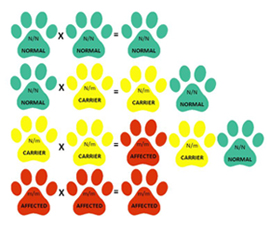Dreibergen Rottweilers
Rottweiler Juvenile Laryngeal Paralysis (JLPP)
Juvenile laryngeal paralysis/polyneuropathy (JLPP) is a very real and horrifically devastating disease in Rottweilers. ADRK reports that currently 21% of the breed population in Germany are carriers and OFA reports that 17% of the breed population in the U.S. are carriers.
Fortunately, a DNA test is available to determine if a dog is a carrier of the mutation gene but sadly, not all breeders are properly testing their dogs. The test is simply a swab of saliva, it takes only minutes for a breeder to get the sample for submission and only 2-3 weeks to receive OFA DNA results. There is NO EXCUSE for a breeder to not test their breeding animals and it is beyond inexcusable for a breeder to ever produce this disease again. The JLPP gene is a simple recessive gene which means that a dog must possess two copies of the gene mutation for the disease to express itself. A dog with only one gene mutation cannot be affected with the disease

Two JLPP clear dogs can only produce JLPP clear puppies. A JLPP carrier dog bred to a JLPP clear dog will produce some clear puppies and some carrier puppies but no puppies will have two copies of the gene which means there can be no expression of the disease in any puppies from that litter. If a JLPP carrier is bred to a JLPP carrier some of the puppies will carry two copies of the gene and be affected with the disease, some will be carriers with only one copy of the gene and some puppies inherit two normal genes. JLPP affected dogs would not likely live long enough to reproduce however if two JLPP affected dogs were bred, 100% of the resulting puppies would be affected having two copies of the JLPP gene.
JLPP is a disease that affects the nerves. One of the longest nerves in the body supplies the muscles of the voice box (larynx). The vocal folds vibrate as air moves over them allowing a dog to bark. When the dog breathes in, muscles in the larynx pull the vocal folds aside so that air can move easily into their lungs. These nerves also help to close the larynx when the dog swallows so they do not choke on their food.
If nerves are unable to convey messages properly, the muscles become weak or paralyzed. The longest nerves are often affected first; hence laryngeal paralysis is the first symptom. The vocal folds cannot be pulled out of the way as the dog breaths in. They vibrate noisily and can obstruct the flow of air into the lungs particularly when the dog is exercised or hot. The dog may also choke on their food or water or regurgitate, which can result in pneumonia.
The next longest nerves in the body go to the back legs, thus they are affected next. The dogs have difficulty getting up and wobble as they walk. Eventually the front legs will also be affected. As the disease progresses, dogs with JLPP can become unable to walk at all..
Affected dogs also have ocular abnormalities such as cataracts and they have a degenerative change in their brains with neuronal vacuolation. They may also have a syndrome referred to as Polyneuropathy with Ocular Abnormalities and Neuronal Vacuolation (POANV).
The symptoms of JLPP normally do not occur until after weaning age and puppies with JLPP eventually will need euthanasia as the disease takes over the bodies normally prior to 1 year old.
In the best interest of our breed, and most of all, for all puppy owners, breeders must ONLY breed litters that cannot produce any puppies affected with JLPP. Breeding with only JLPP DNA tested dogs is the only way to ensure that the puppies will not be afflicted with this horrific disease
Click here for an excellent video about the effects of JLPP - but be aware before you watch, the video is heartbreaking......
This article is protected by copyright and may not be reproduced online or in print, in whole or in part without prior consent of the authors.